| |
Feature
Is There a Doctor in the Barn?
PHOTOS BY KURT STIER
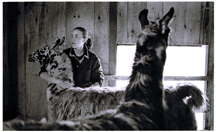 |
Amy Peterson gets a firm hold on a female llama about to
be vaccinated
|
Every year dozens of fourth-year students at Tufts veterinary school
leave the familiar setting of their North Grafton, Massachusetts,
campus for the rolling farmland of northeastern Connecticut. Here
in South Woodstock, a proclivity toward agriculture gives students
at the Ambulatory Clinic ample opportunity to fulfill the four-week
block of their ambulatory rotation. "They learn by doing," says
Dr. Craig Embree, one of six veterinarians who take the students
on rounds that routinely include dairy cows, show horses, goats
and the occasional bison. Most students don't have farm or large-animal
backgrounds, says Embree, but they are rarely daunted by examining
a sick animal that can be considerably larger than they are and
sometimes reluctant to cooperate. A 1,500-pound Holstein or a skittish
llama isn't intimidating, he points out, to those who come with
a genuine desire to learn. "On the whole, most are very excited
to be down here and they develop an ease by spending time with the
animals," he says. "The rotation gives them something they haven't
experienced before and offers challenging problems as they develop
their clinical skills."
|
The Tufts Ambulatory Clinic.
|
 |
|
The daily menagerie of animals might include
a patient such as Buddy, a billy goat, who has his hoofs trimmed
by Heather Berry as fellow students Carolyn McKay and Amy
Peterson look on.
|
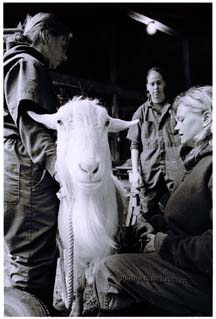 |
|
About 60 percent of the calls that the Ambulatory
Clinic responds to are from dairy farms, says Dr. Embree (right).
|
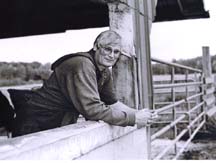 |
|
The last stop of the day responds to a call
from milker Sue Buckman-Friedlander who was concerned when
her favorite of the herd, "Cybil McCow," a dairy cow she raised
from a calf, was coughing and seemed "a bit off." The diagnosis
of pneumonia was followed up with a regime of antibiotics.
|
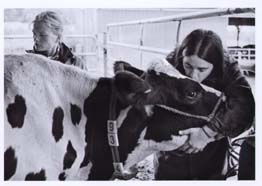 |
|
The basic necessities-coveralls, high boots
for mud and manure, and a weathered doctor's bag-are visible
reminders their profession comes with a deep value for animal
care.
|
 |
|
While most of the veterinary students don't
have farm backgrounds, their love of animals makes them eager
learners. Some 80 percent are women; at left, Heather Berry,
Amy Peterson and Carolyn McKay are framed by a barn door.
|
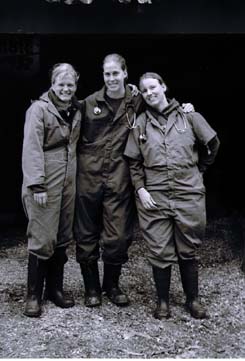 |
Read about John Pollock, V97, a large
animal vet.
top
|






